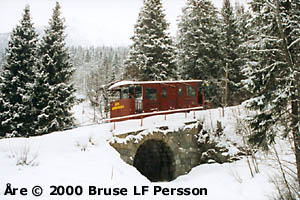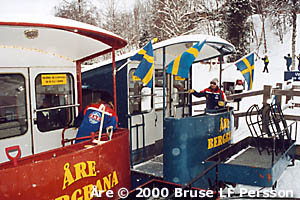|
s
How a funicular works

The red car of the funicular at Åre, showing the open platforms and side doors.
|
Cars
The earliest cars were very similar to the tramcars of the time, with center compartments and open platforms at the front and rear. The cars were divided into multiple compartments at different levels, like a staircase, to give each compartment a horizontal floor. These cars were usually boarded via the front and rear platforms. Some funiculars, such as the one at Skansen, have several side doors, one for each compartment.
Crew
The crew used to operate funiculars varies. Most of them are operated by an engineman, or are completely automatic.
Engine attendant
At the funicular at Skansen, for example, the engine attendant sits at the lower station and monitors the upper station and portions of the line with closed-circuit television. He closes and opens the doors and starts the motor. The cars stop automatically when they reach the correct point at each station.

The two conductors take the opportunity to plan the evening's activities when the cars meet at the center station. Funicular at Åre.
|
Conductors
The funicular at Åre, among others, uses conductors. They give a "ready" signal by turning a key at each station. When both conductors, one on each car, have given this signal, the line starts automatically.
Driver
Just as with tramways, some funiculars have drivers on the cars. One example is the Fløibanen at Bergen, Norway, where there are three middle stations that the cars stop at. Otherwise, this line works like most other funiculars, with a cable, etc.
Automation
There are many completely automated funiculars. Most of these are more like diagonal lifts. Just as with a conventional lift, passengers use "up," "down" and "call" buttons to call the car and tell it where they want to go.
 previous page - contents - next page previous page - contents - next page 
© Text och photo: Bruse LF Persson
|